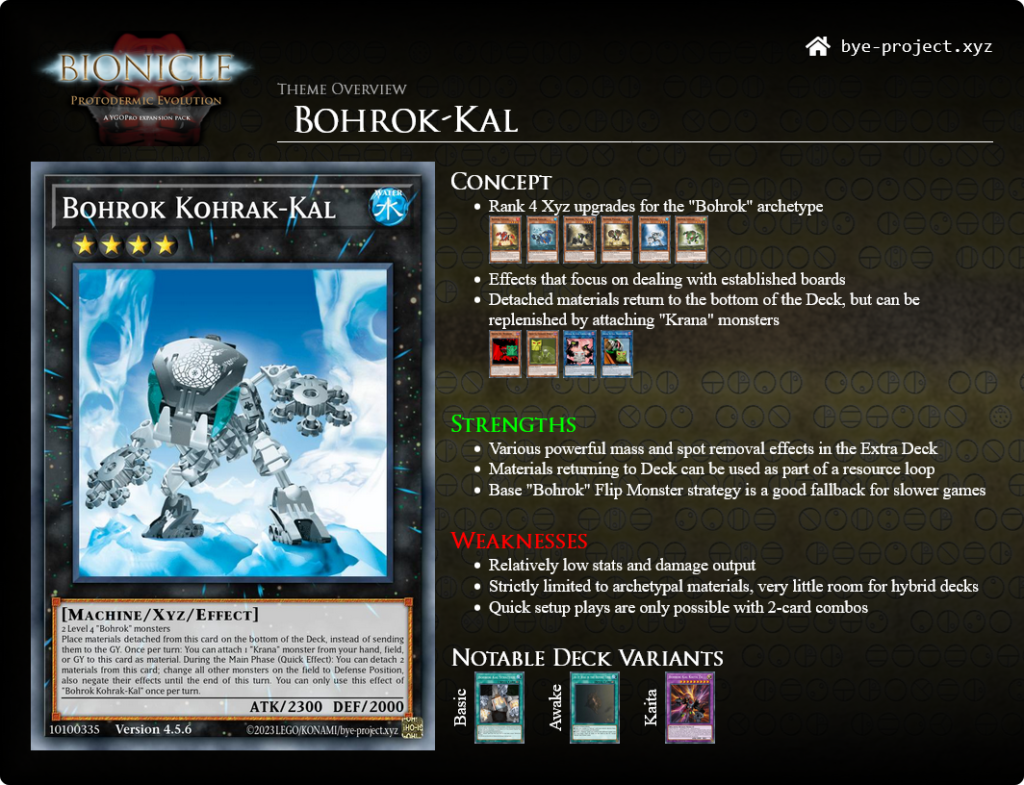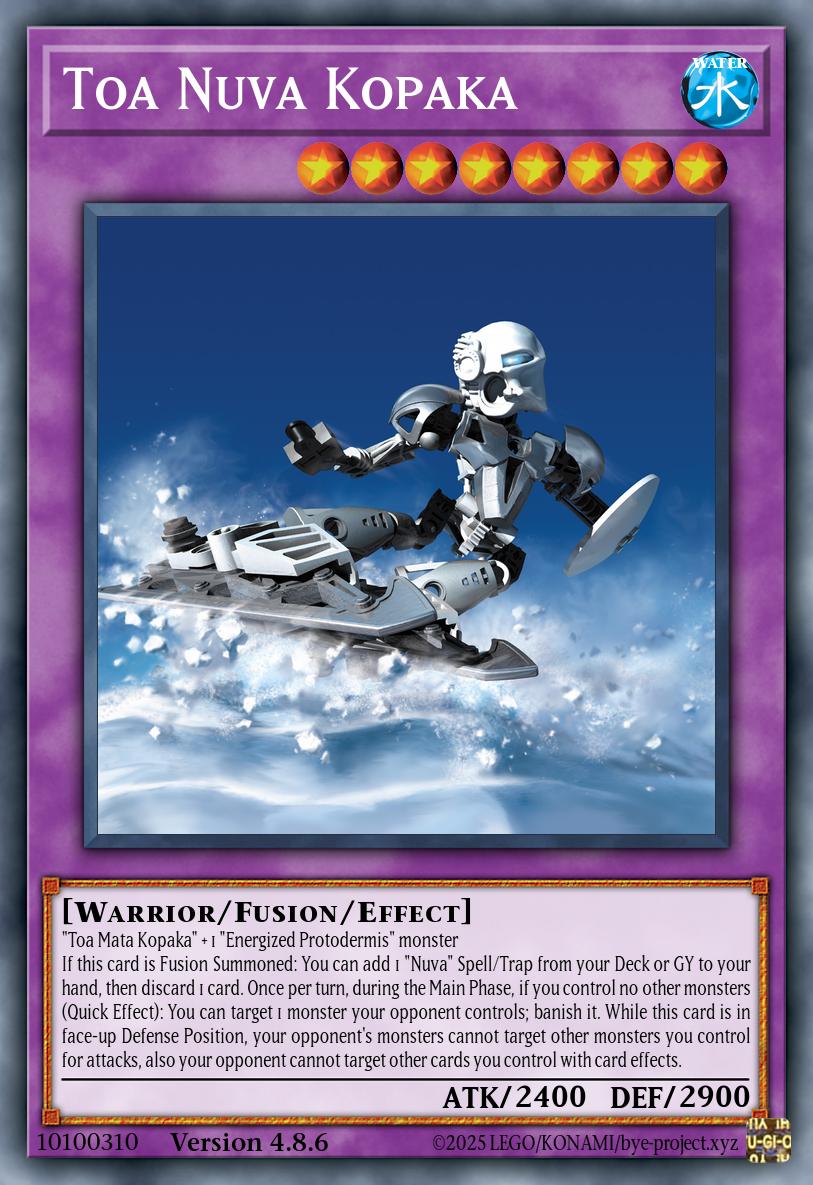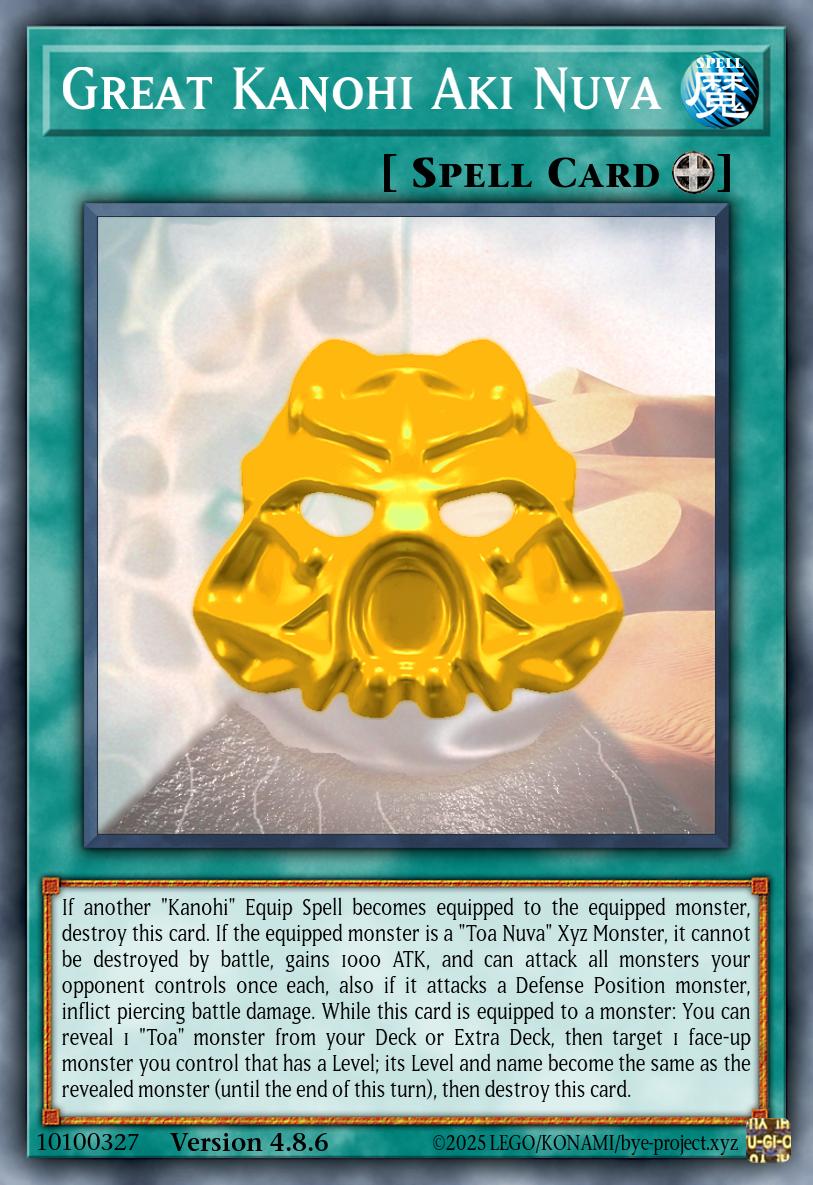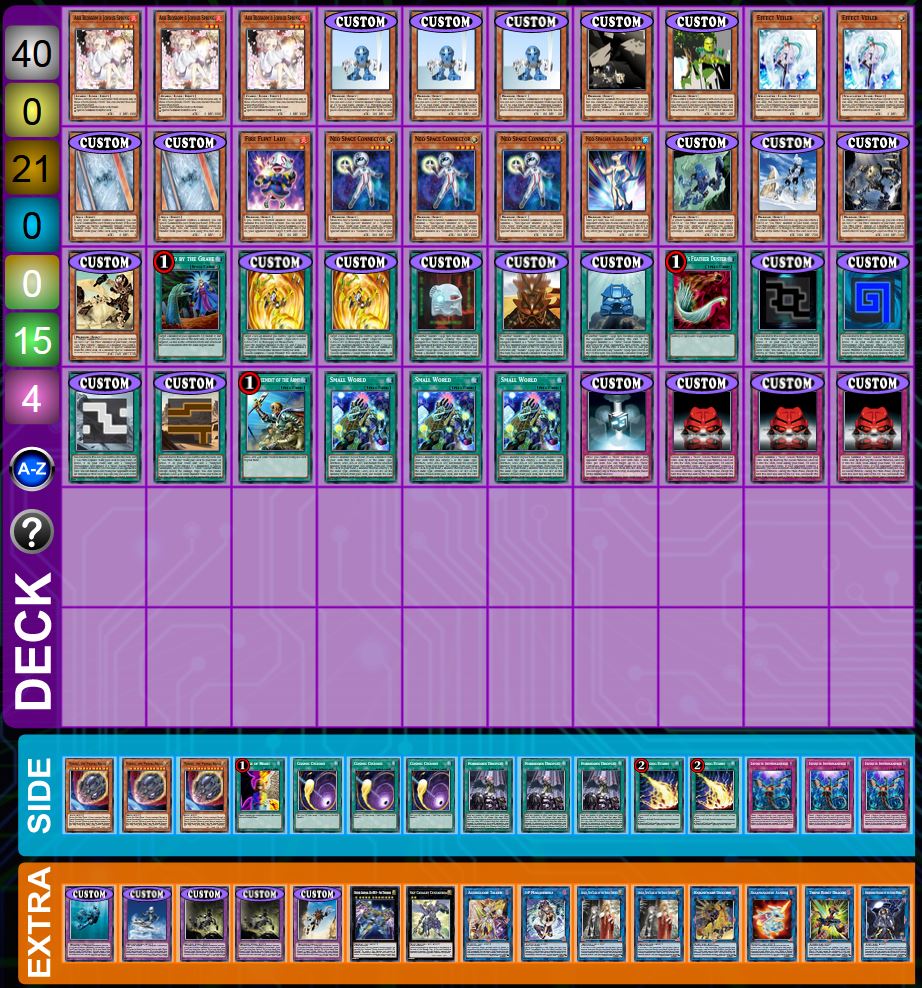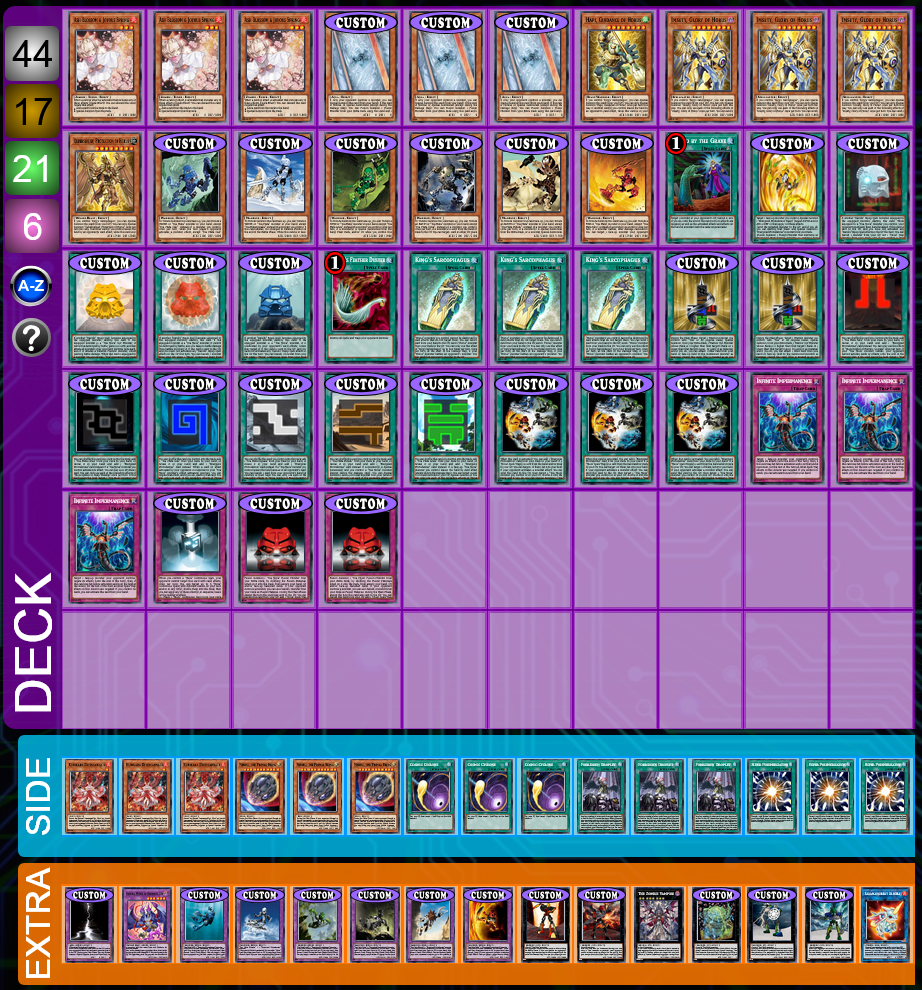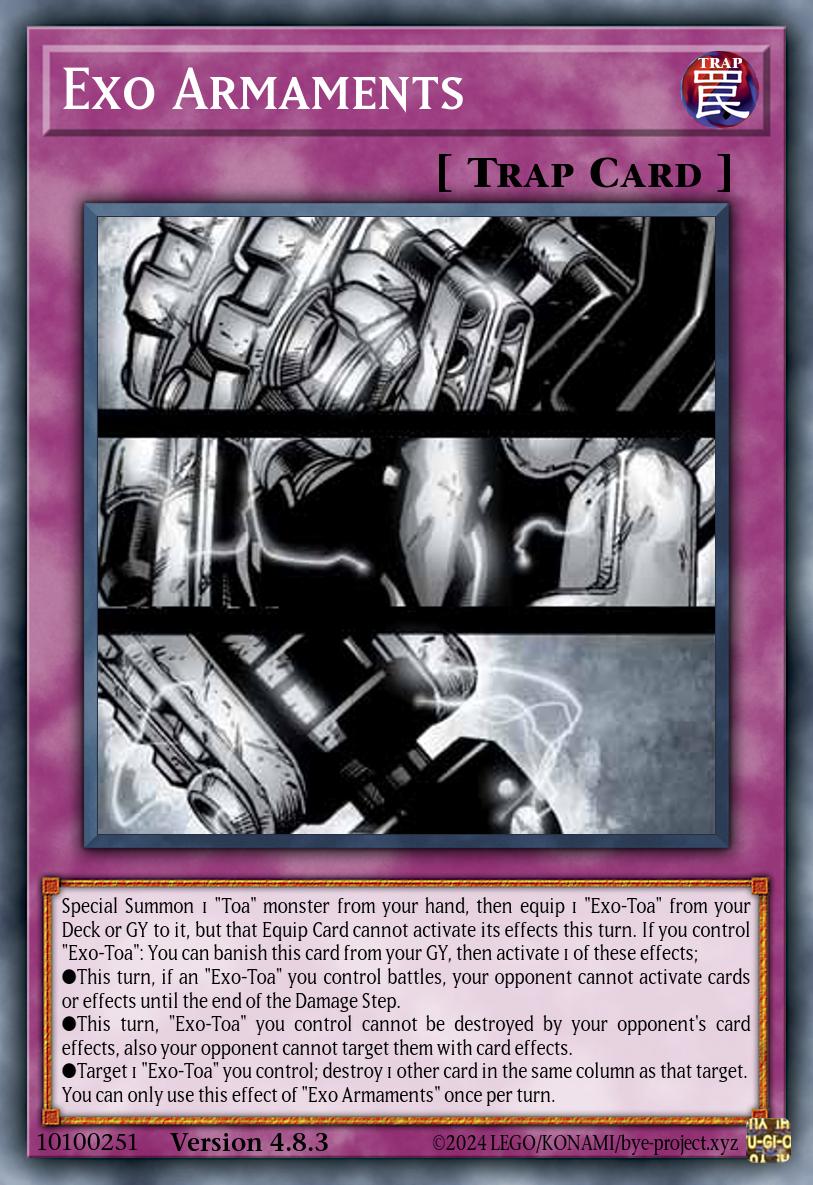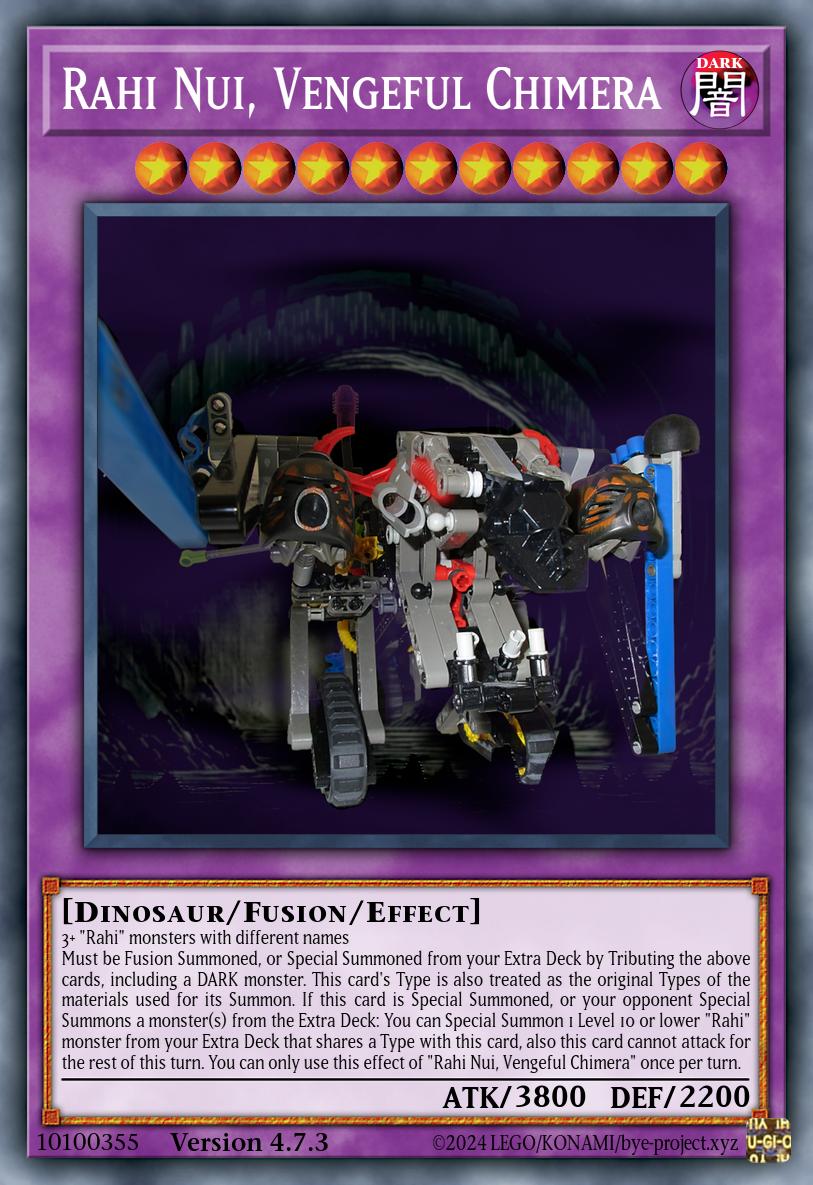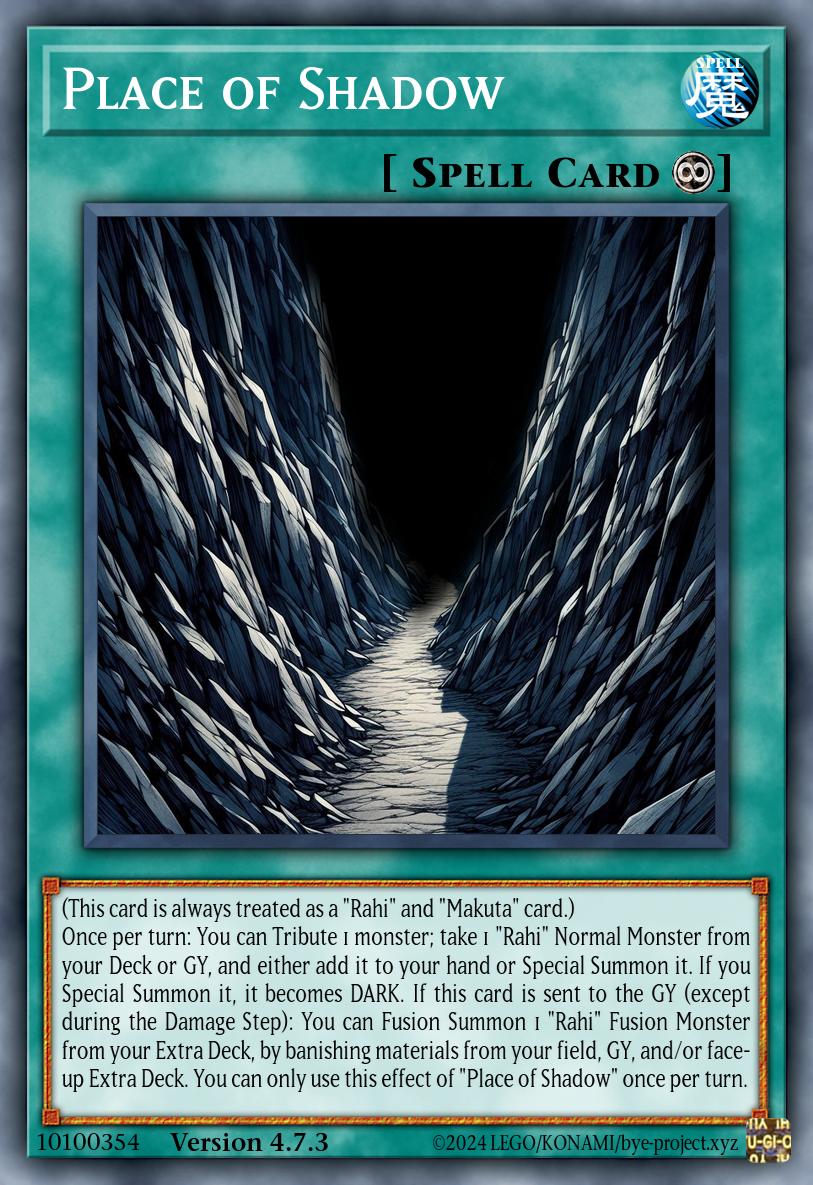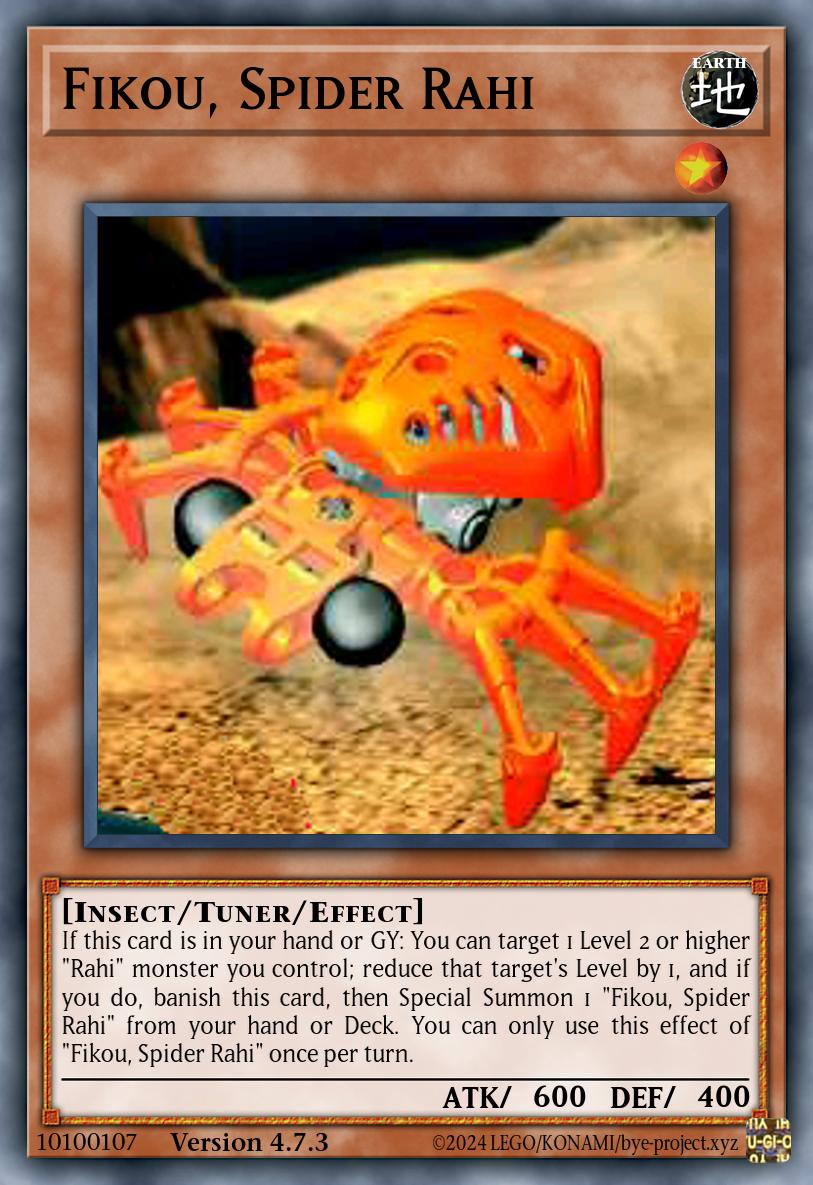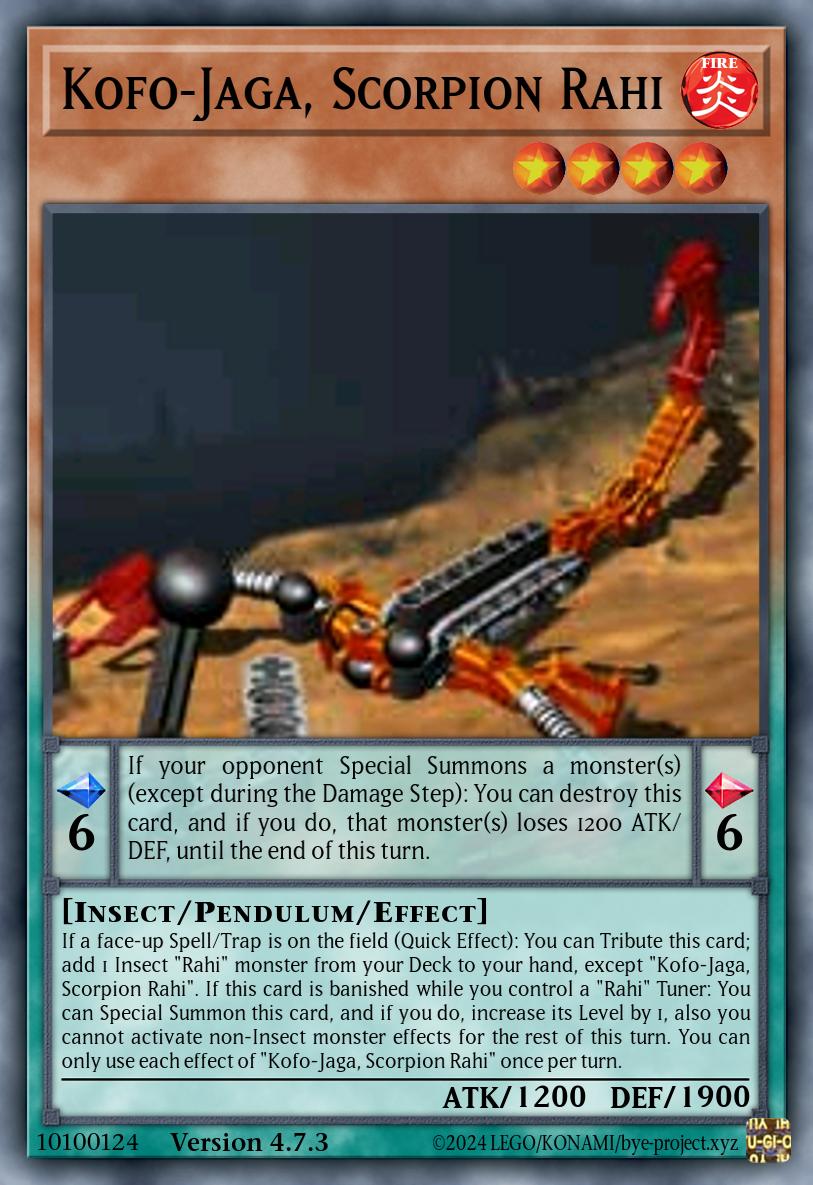What awaits at the end of evolution? This, apparently.
With the aesthetic group shot out of the way, actual readable card images are still found on the BPEV page, or you can watch everything nicely presented in the demo compilation below. I recommend the latter, for one thing it took way more effort to make.
(Note: Some decks from previous versions, like the Toa Nuva builds that relied on Isolde, have now been removed.)
Much like the previous set, this finalized release consists of maintenance and cleanup on all the card texts and scripts, including swapping out those auxiliary function calls that got deprecated right as I finished everything else (thanks Edo). Some cards actually got away without any PSCT changes, if you’re curious you can try to find them on the Card Viewer page.
Anyway, that by itself of course doesn’t explain the big version number jump from 4.8.3 to 4.8.6. That part is justified by some last-minute experimentation and functional updates to stuff like the Vahi cards that still needed to cook for a bit – let’s get into the meat.
Updated

Legendary Kanohi Vahi, Mask of Time
Equip SpellYou can only control 1 “Vahi” Equip Spell. If another “Kanohi” Equip Spell becomes equipped to the equipped monster, destroy this card. The equipped monster cannot attack or activate its effects, also your opponent cannot target it with card effects. Once per turn, while this card is equipped to a “Toa” or “Makuta” monster you control: You can add 1 “Vahi” card from your Deck or GY to your hand, except an Equip Spell. If this card is destroyed or banished by your opponent’s card effect: Both players skip their next Battle Phase.

Vahi Freeze
Quick-Play SpellActivate 1 of these effects;
●Add 1 “Vahi” Equip Spell from your Deck or GY to your hand.
●If you control a “Vahi” Equip Spell: Target 1 face-up card on the field; until the end of this turn, its effects are negated, also it cannot be destroyed, or banished, by card effects.
If this card is sent from the field to the GY: You can draw 1 card, but skip your next Draw Phase. You can only use this effect of “Vahi Freeze” once per turn.

Legendary Kanohi Vahi, Mask of Time
Equip SpellIf another “Kanohi” Equip Spell becomes equipped to the equipped monster, destroy this card. The equipped monster cannot attack or activate its effects, also your opponent cannot target it with card effects. If you control the equipped monster: You can add 1 “Vahi” card from your Deck or GY to your hand, except an Equip Spell. You can only use this effect of “Legendary Kanohi Vahi, Mask of Time” once per turn.

Vahi Freeze
Quick-Play SpellActivate 1 of these effects;
●Target 1 face-up monster on the field; equip it with 1 “Vahi” Equip Spell from your Deck, GY, or face-up field that can equip to it.
●If you control a “Toa” or “Makuta” monster equipped with a “Vahi” Equip Spell: Target 1 face-up card on the field; until the end of this turn, its effects are negated, also it cannot be destroyed, or banished, by card effects.
If this card is sent from the field to the GY: You can Set it, and if you do, skip your next Draw Phase. You can only use this effect of “Vahi Freeze” once per turn.
I did mention these weren’t quite there yet by the time of the previous release, so some major restructuring happened in those last few minor versions. In summary, the Vahi itself slimmed down, losing its weirder restrictions to simply become a monster-locking archetype searcher; special thanks to DuDono from the EDOPro Discord for setting me on the right path with that. The new incarnation is somewhat similar to Grief Tablet, including the fact that the effect to search is no longer locked behind an archetype requirement. Instead, that restriction has moved to the time-freezing effect of the search target, because really it makes much more sense to check for proper Kanohi usage qualifications at the point where the actual time powers get used.
Other than that, Vahi Freeze has experienced two significant changes: Its first effect, instead of simply adding the Vahi, equips it directly to a monster, and can even change the equip target of a copy that is already on the field (think Tailor of the Fickle). This adds a ton of versatility, letting you use the lockdown effects as a (fairly weak) form of disruption or shift the burden from one of your monsters to another depending on who you need available. The floating effect that skips your Draw Phase also has a different payoff now, resetting the card itself instead of granting a random draw. By doing so, the problem where the cyclic Vahi “engine” will sometimes run out of gas all on its own has been mostly fixed, and the flavor of it all is much more befitting of a “Freeze” that simply keeps the card on the field and the top card of your Deck out of reach.
The lore element where breaking the Vahi destroys time has been lost in this streamlining, but I’m probably just going to make a new card about that when it actually becomes relevant.
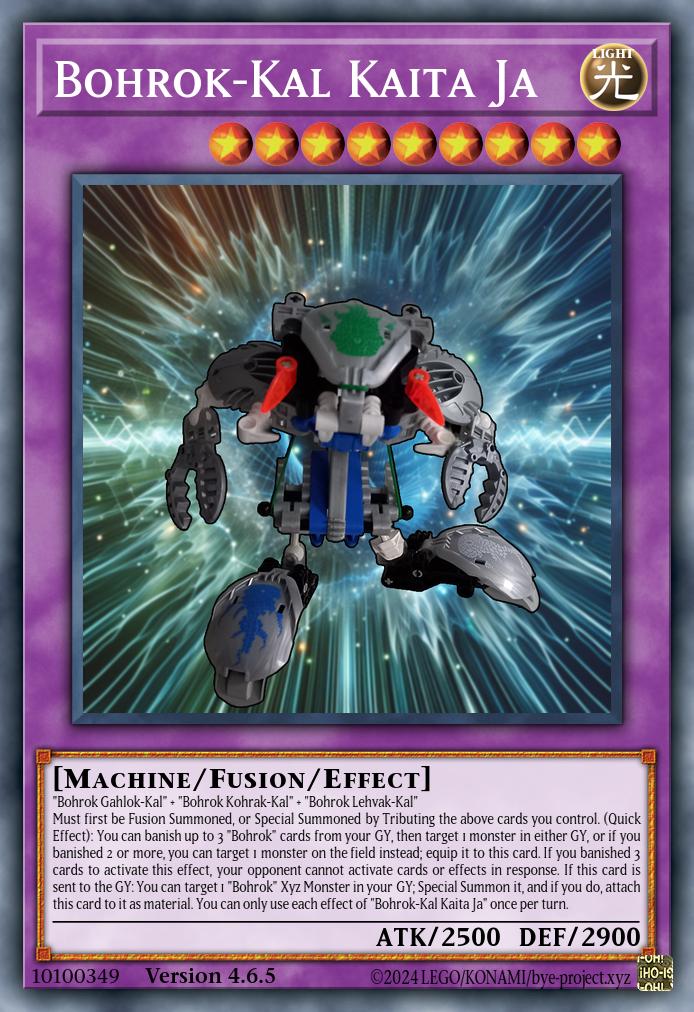
Bohrok-Kal Kaita Ja
Fusion Effect MonsterLevel 9 | LIGHT Machine | ATK 2500 / DEF 2900“Bohrok Gahlok-Kal” + “Bohrok Kohrak-Kal” + “Bohrok Lehvak-Kal”
Must first be Fusion Summoned, or Special Summoned by Tributing the above cards you control. (Quick Effect): You can banish up to 3 “Bohrok” cards from your GY, then target 1 monster in either GY, or if you banished 2 or more, you can target 1 monster on the field instead; equip it to this card. If you banished 3 cards to activate this effect, your opponent cannot activate cards or effects in response. If this card is sent to the GY: You can target 1 “Bohrok” Xyz Monster in your GY; Special Summon it, and if you do, attach this card to it as material. You can only use each effect of “Bohrok-Kal Kaita Ja” once per turn.

Bohrok-Kal Kaita Ja
Fusion Effect MonsterLevel 9 | LIGHT Machine | ATK 2500 / DEF 2900“Bohrok Gahlok-Kal” + “Bohrok Kohrak-Kal” + “Bohrok Lehvak-Kal”
Must first be either Fusion Summoned, or Special Summoned from your Extra Deck by Tributing the above cards. (Quick Effect): You can banish 1 “Bohrok” card from your GY, then target 1 other face-up monster on the field or in either GY; equip it to this card. Your opponent cannot activate cards or effects in response to this effect’s activation. If this card is sent to the GY: You can target 1 “Bohrok” Xyz Monster in your GY; Special Summon it, and if you do, attach this card to it as material. You can only use each effect of “Bohrok-Kal Kaita Ja” once per turn.
Some changes are planned in advance, others come up suddenly when you run into a card text that balloons beyond all good sense if outfitted with the final coat of PSCT polish. In this way, the Bohrok-Kal Kaita Ja went back to a version I tested mid-development and deemed “not interesting enough”, where it just banishes 1 card at a time for its it cost and gets the full package of equipping from hand/field while not allowing responses. Realistically, making these Kaita is so convoluted that the buff from this change shouldn’t be an issue, and this way it still works as a looming threat of uncounterable removal you can theoretically make (to defeat Wairuha Nuva , of course).

Krana Yo-Kal, Excavator
Link Effect MonsterLink-1 [↖] | DARK Zombie | ATK 01 “Bohrok” or “Krana” monster
Cannot be used as Link Material. If an opponent’s monster this card points to battles a “Bohrok” monster, that opponent’s monster’s ATK/DEF become 0 during the Damage Step only. A “Bohrok” Xyz Monster that has this card as material gains this effect.
●This card can attack directly, also if it attacks, your opponent cannot activate cards or effects until the end of the Damage Step.
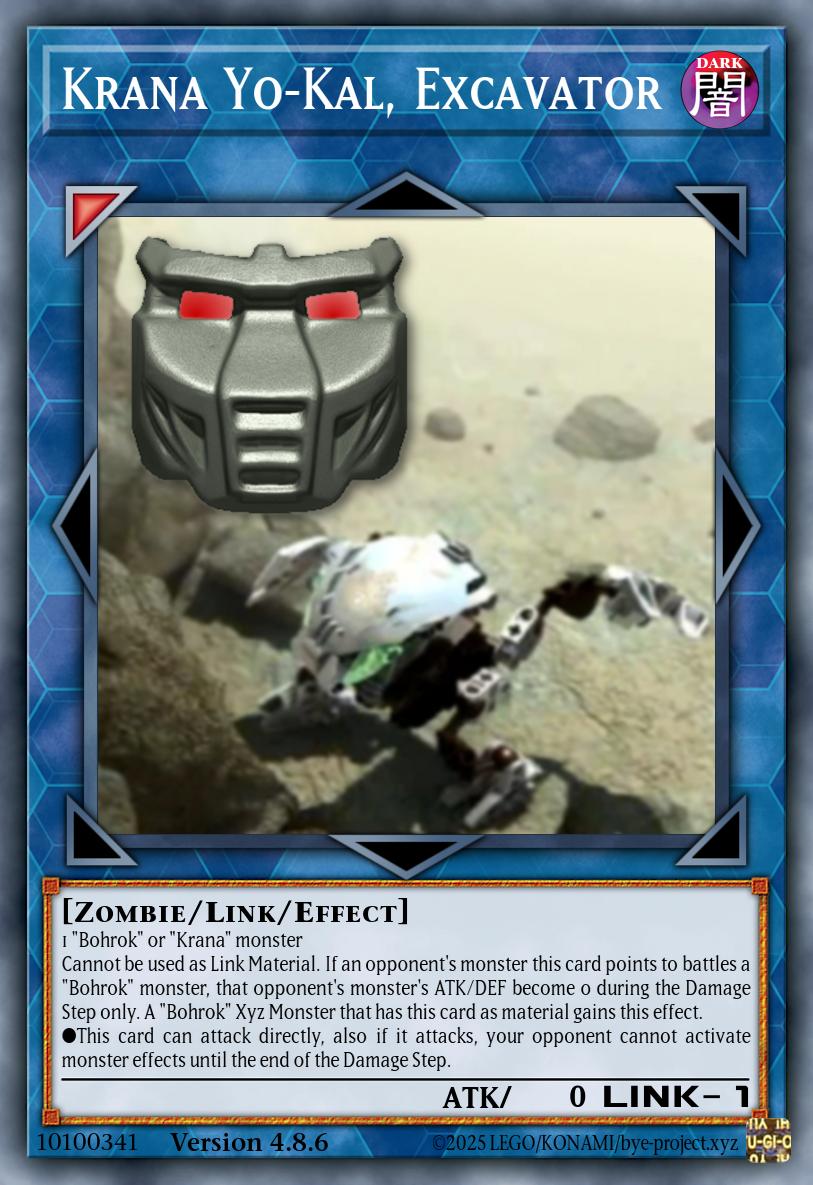
Krana Yo-Kal, Excavator
Link Effect MonsterLink-1 [↖] | DARK Zombie | ATK 01 “Bohrok” or “Krana” monster
Cannot be used as Link Material. If an opponent’s monster this card points to battles a “Bohrok” monster, that opponent’s monster’s ATK/DEF become 0 during the Damage Step only. A “Bohrok” Xyz Monster that has this card as material gains this effect.
●This card can attack directly, also if it attacks, your opponent cannot activate monster effects until the end of the Damage Step.
A slight change to the Krana Yo-Kal for lore reasons: Instead of its tunneling ability guarding you against all responses while attacking, it only covers monster effects, so that the Bohrok-Kal don’t have a built-in way to escape devastation at the hands of Nuva Overcharge . This was always primarily meant to guard the effects of Pahrak-Kal and Krana Xa-Kal , so keeping those safe from boss monsters that negate activations still mostly accomplishes the mission.

Energized Protodermis Chamber
Effect MonsterLevel 2 | LIGHT Aqua | ATK 0 / DEF 0If only your opponent controls a monster, you can Special Summon this card (from your hand). If this card is Normal or Special Summoned (except during the Damage Step): You can Fusion Summon 1 Fusion Monster from your Extra Deck using this card and 1 monster in your hand as material. If this card is used as material for a Fusion Summon, except by its own effect: Target 1 Special Summoned monster on the field; send it to the GY. You can only use this effect of “Energized Protodermis Chamber” once per turn.

Energized Protodermis Chamber
Effect MonsterLevel 2 | LIGHT Aqua | ATK 0 / DEF 0If only your opponent controls a monster, you can Special Summon this card (from your hand). If this card is Normal or Special Summoned (except during the Damage Step): You can Fusion Summon 1 Fusion Monster from your Extra Deck, using this card you control and 1 monster from your hand as material. If this card is used as material for a Fusion Summon, except by its own effect: Target 1 Special Summoned monster on the field; send it to the GY.
The mandatory effect of Energized Protodermis Chamber has lost its hard once per turn clause, after all the substance isn’t going to stop being destructive just because you already threw something in that turn. This is something of a buff as you can now fuse away multiple in a turn to clear multiple Special Summoned monsters, but that also requires multiple other cards to enable the Fusion Summons and only matters against established boards, so it should be fine. However, the mandatory effect on Flow did maintain its limitation, so no milling out the whole Extra Deck with bullshit loops turn 1.

Toa Nuva Pohatu
Fusion Effect MonsterLevel 8 | EARTH Warrior | ATK 2800 / DEF 2100“Toa Mata Pohatu” + 1 “Energized Protodermis” monster
If this card is Fusion Summoned: You can add 1 “Nuva” Spell/Trap from your Deck or GY to your hand, then discard 1 card. (Quick Effect): You can destroy Spells/Traps your opponent controls, up to the number of Rock monsters you control +1. You can only use this effect of “Toa Nuva Pohatu” once per turn.

Toa Nuva Pohatu
Fusion Effect MonsterLevel 8 | EARTH Warrior | ATK 2800 / DEF 2100“Toa Mata Pohatu” + 1 “Energized Protodermis” monster
If this card is Fusion Summoned: You can add 1 “Nuva” Spell/Trap from your Deck or GY to your hand, then discard 1 card. (Quick Effect): You can destroy 1 Spell/Trap your opponent controls, or up to 2 if you control a Rock monster. You can only use this effect of “Toa Nuva Pohatu” once per turn.
Another change with credit attached, this time to u/RedRedditReadReads on, well, Reddit. The infinite scaling on Pohatu Nuva’s backrow destruction, while a cool mathematical trick, is kind of overtuned for no reason if you ever manage to make the guy in an actual Rock deck. So I’ve lowered the ceiling to 2 like his Mata form , leaving the benefits of the Nuva upgrade as “only” the free activation timing and the fact that neither card has to be targeted. Good enough, I say.
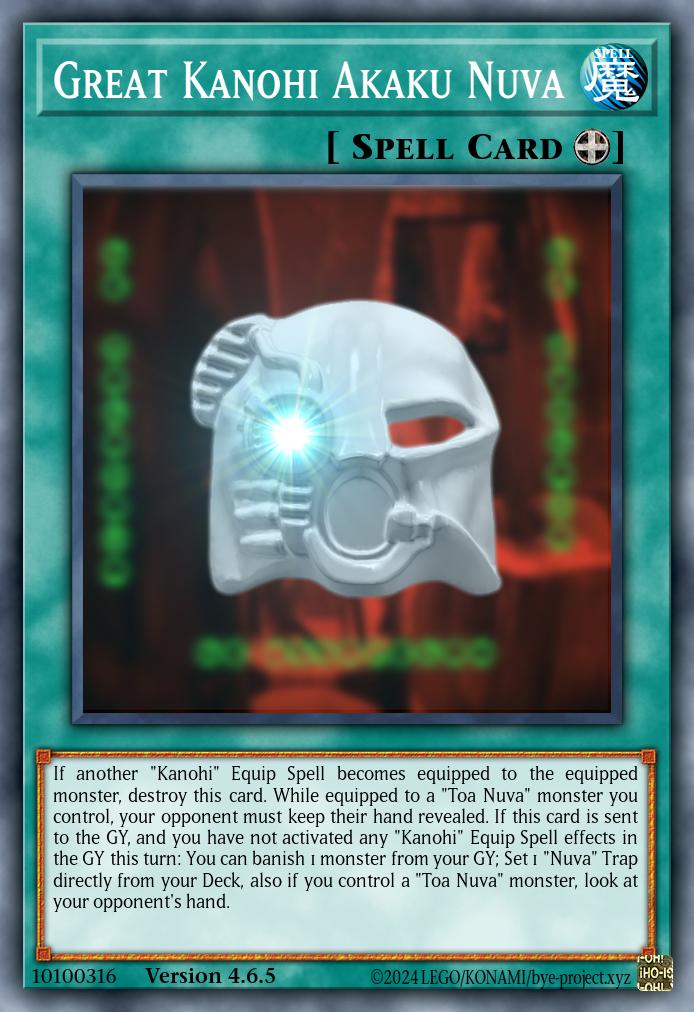
Great Kanohi Akaku Nuva
Equip SpellIf another “Kanohi” Equip Spell becomes equipped to the equipped monster, destroy this card. While equipped to a “Toa Nuva” monster you control, your opponent must keep their hand revealed. If this card is sent to the GY, and you have not activated any “Kanohi” Equip Spell effects in the GY this turn: You can banish 1 monster from your GY; Set 1 “Nuva” Trap directly from your Deck, also if you control a “Toa Nuva” monster, look at your opponent’s hand.

Great Kanohi Akaku Nuva
Equip SpellIf another “Kanohi” Equip Spell becomes equipped to the equipped monster, destroy this card. While this card is equipped to a “Toa Nuva” monster you control, your opponent must keep their hand revealed. If this card is sent to the GY, and you have not activated a “Kanohi” Equip Spell effect in the GY this turn: You can banish 1 monster from your GY; Set 1 “Nuva” Trap from your Deck, also if you control a “Toa Nuva” monster, you can banish 1 random card from your opponent’s hand, until the End Phase.
I was always a bit uncomfortable with the Akaku Nuva just casually granting full hand knowledge as the bonus of its GY effect, so during the final tweaks I pulled the trigger and downgraded that a bit, by making it a hand snipe similar to what already existed on the base Akaku . This effectively gives you knowledge of 1 card only, while seeing the rest requires finding a way to properly equip the mask, and in theory it could even take out some kind of handtrap (though that isn’t likely to matter). Note that unlike other bonuses, this one is optional, so you can still get a Trap from Deck even if there’s nothing in your opponent’s hand.
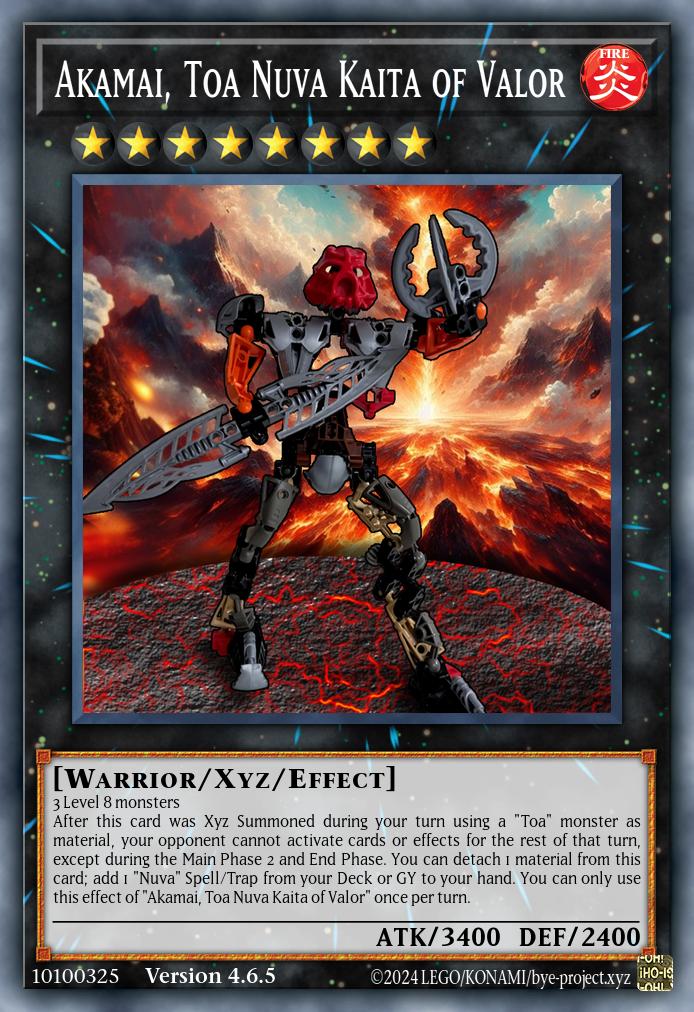
Akamai, Toa Nuva Kaita of Valor
Xyz Effect MonsterRank 8 | FIRE Warrior | ATK 3400 / DEF 24003 Level 8 monsters
After this card was Xyz Summoned during your turn using a “Toa” monster as material, your opponent cannot activate cards or effects for the rest of that turn, except during the Main Phase 2 and End Phase. You can detach 1 material from this card; add 1 “Nuva” Spell/Trap from your Deck or GY to your hand. You can only use this effect of “Akamai, Toa Nuva Kaita of Valor” once per turn.

Akamai, Toa Nuva Kaita of Valor
Xyz Effect MonsterRank 8 | FIRE Warrior | ATK 3400 / DEF 24003 Level 8 monsters
You can detach 1 material from this card; add 1 “Nuva” Spell/Trap from your Deck or GY to your hand. You can only use this effect of “Akamai, Toa Nuva Kaita of Valor” once per turn. After this card was Xyz Summoned during your turn using a “Toa” monster as material, apply these effects for the rest of that turn, except during the Main Phase 2 and End Phase.
●Your opponent cannot activate cards or effects. ●You cannot Special Summon monsters.
Akamai Nuva, whose concept is basically “Azathot but for beatdown only”, obtained an additional restriction to guard against twisting the idea into more unfun directions. That is, it now also locks its own controller out of Special Summoning for the same duration the opponent’s effects are turned off, so you’re not getting to do any setup combos under that protection. Just search yourself an Aki Nuva , go to battle, and unga that bunga like the dev intended. Use your Normal Summon if you absolutely have to put another body on the field in Main Phase 1, that’s always an option.

Wairuha, Toa Nuva Kaita of Wisdom
Xyz Effect MonsterRank 8 | WIND Warrior | ATK 3000 / DEF 30003 Level 8 monsters
When your opponent activates a card or effect while this card has a “Toa” monster as material (Quick Effect): You can detach 1 material from this card; negate the activation, and if you do, you can banish both that card and the top card of either player’s Deck. Then, if you banished 2 different card types (Monster, Spell, Trap), draw 1 card. You can detach 1 material from this card; add 1 “Nuva” Spell/Trap from your Deck or GY to your hand. You can only use 1 “Wairuha, Toa Nuva Kaita of Wisdom” effect per turn, and only once that turn.
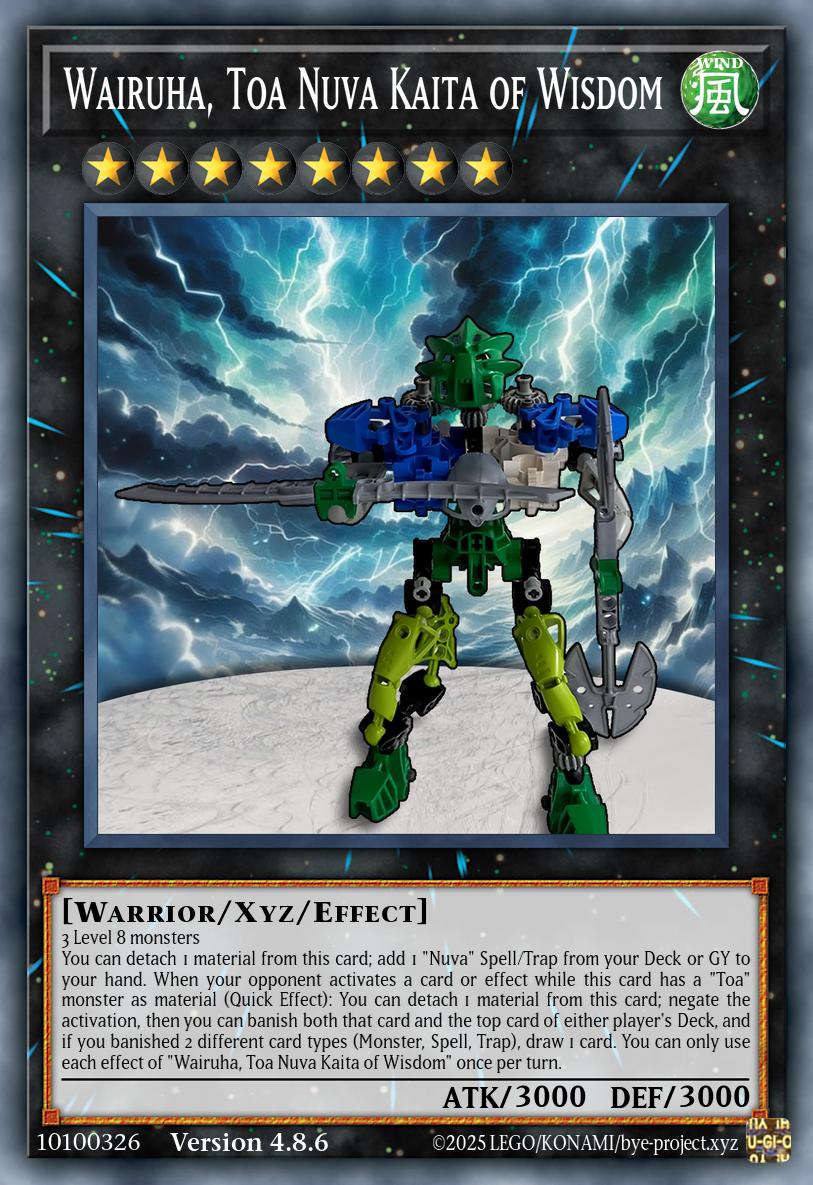
Wairuha, Toa Nuva Kaita of Wisdom
Xyz Effect MonsterRank 8 | WIND Warrior | ATK 3000 / DEF 30003 Level 8 monsters
You can detach 1 material from this card; add 1 “Nuva” Spell/Trap from your Deck or GY to your hand. When your opponent activates a card or effect while this card has a “Toa” monster as material (Quick Effect): You can detach 1 material from this card; negate the activation, then you can banish both that card and the top card of either player’s Deck, and if you banished 2 different card types (Monster, Spell, Trap), draw 1 card. You can only use each effect of “Wairuha, Toa Nuva Kaita of Wisdom” once per turn.
Wairuha Nuva got a much subtler change of making both of the effects usable in the same turn. I initially didn’t do this because negating a response to a search that can add a card that makes it unaffected felt a bit toxic, but on further consideration, making this with a Toa so it gets the negate requires enough effort and previous disruptable play that you really should be allowed to do that. After all, a properly made Akamai Nuva also guards his own search with the lockdown effect.

Naming Day
SpellTarget 1 Warrior monster you control; Tribute it, and if you do, Special Summon 1 Level 4 or lower Warrior monster from your hand or Deck, with the same original Attribute, but a different original name and a higher original Level than the Tributed monster. You can banish this card and 1 Warrior monster from your GY, then target 1 face-up monster you control; its name is treated as the banished monster’s, until the end of your opponent’s turn. You can only activate 1 “Naming Day” per turn.
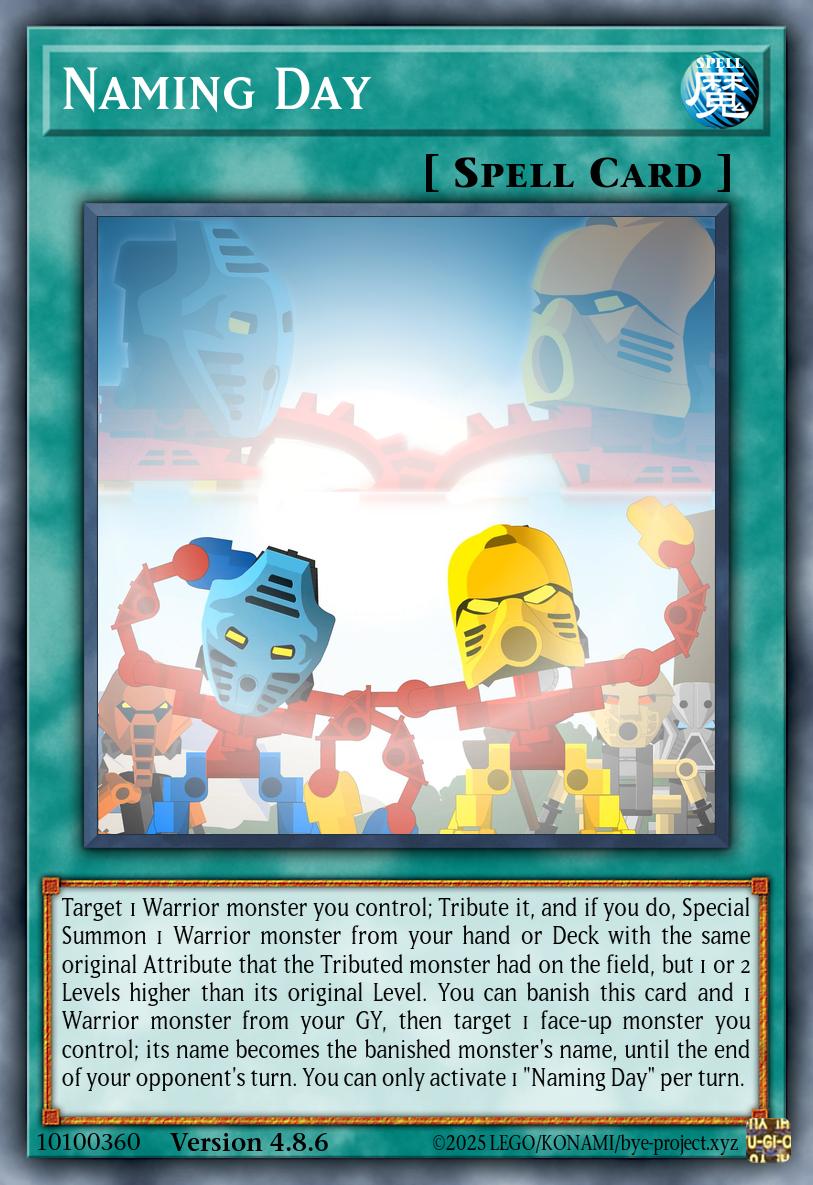
Naming Day
SpellTarget 1 Warrior monster you control; Tribute it, and if you do, Special Summon 1 Warrior monster from your hand or Deck with the same original Attribute that the Tributed monster had on the field, but 1 or 2 Levels higher than its original Level. You can banish this card and 1 Warrior monster from your GY, then target 1 face-up monster you control; its name becomes the banished monster’s name, until the end of your opponent’s turn. You can only activate 1 “Naming Day” per turn.
The final card in the set also gets a bit of a fix for its second appearance in a release. Where Naming Day previously had a hard limit to Level 4 or lower, it now instead supports any jump of 1 or 2 Levels; so 1->4 no longer works, but 2->4 and 3->4 are fine, and lots of new options like 4->5 and 6->8 have appeared. The main motiviation for this was a deckbuilding issue I came to notice: If you have Level 4 Warriors you want to Summon with this, they’re probably also good to simply draw and Normal Summon, so you’re going to run multiple copies, and as a mostly unsearchable Spell Card the same is likely true of the Naming Day itself. This then leads to fairly probable situations where your hand has a Level 4 + Naming Day, which is a combination where the Spell does nothing! Now, however, you have the theoretical option to include a 1-of Level 5 or 6 (e.g. a Toa), maybe even a 7 or 8 to build off that, and so on. You might choose not to, but the possibility being there feels good, and the additional targets shouldn’t enable anything too broken considering Transmodify has always been able to do more or less the same for all Types.

Rahi from the Depths
TrapTarget any number of “Rahi” monsters you control; all monsters your opponent currently controls lose ATK/DEF equal to the total ATK of those monsters you control (until the end of this turn), then you can destroy 1 monster your opponent controls with 0 ATK or DEF. You can banish this card from your GY; Special Summon 1 Fish, Sea Serpent, or Aqua “Rahi” monster from your GY or banishment, but its ATK/DEF become 0. You can only use 1 “Rahi from the Depths” effect per turn, and only once that turn.

Rahi from the Depths
TrapTarget any number of “Rahi” monsters you control; all monsters your opponent currently controls lose ATK/DEF equal to the total ATK of those monsters you control (until the end of this turn), then you can destroy 1 monster your opponent controls with 0 ATK. You can banish this card from your GY; Special Summon 1 Fish, Sea Serpent, or Aqua “Rahi” monster from your GY or banishment, but its ATK/DEF become 0. You can only use 1 “Rahi from the Depths” effect per turn, and only once that turn.
For Rahi from the Depths, the destruction option was slightly downgraded to only consider the ATK stat, though it still lowers both ATK and DEF. What I actually wanted to do was “0 ATK and DEF” rather than “or”, so it doesn’t trivially deal with big monsters that happen to not be so big the other way, but then it wouldn’t have worked on Link Monsters at all, so this is how it ended up.
And that’s it for the final tweaks on BPEV! But wait, there’s more. Because the Rahi Update also occured during this development cycle a few months ago, there are additional changes to be reported on that end as well.

Rahi Swarm
SpellAdd up to 2 “Rahi” monsters with the same Type from your Deck to your hand, then, if you added 2 monsters including an Effect Monster, banish 1 card from your hand, face-down. You can banish this card from your GY, then target 1 face-up Monster Card you control; Special Summon 1 “Rahi” monster with the same Type and an equal or lower Level from your GY. You can only use 1 “Rahi Swarm” effect per turn, and only once that turn.

Rahi Swarm
SpellAdd up to 2 “Rahi” monsters with the same Type, but different names, from your Deck to your hand, then, if you added 2 monsters including an Effect Monster, banish 1 card from your hand, face-down. For the rest of this turn after this card resolves, you cannot Pendulum Summon, except “Rahi” monsters. You can banish this card from your GY, then target 1 face-up Monster Card you control; Special Summon 1 “Rahi” monster with the same Type and an equal or lower Level from your GY. You can only use 1 “Rahi Swarm” effect per turn, and only once that turn.
The omnipresent search Spell Rahi Swarm was simply outfitted with a Pendulum Summon lock to only Rahi. This does not matter at all in-archetype, but I felt it might be necessary since you can technically add a pair of Normal Pendulums for a generic 1-8 scale at no cost.

Kane-Ra, Bull Rahi
Normal Pendulum MonsterLevel 7 | Scale 1/1 | EARTH Beast | ATK 2600 / DEF 2300[ Pendulum Effect ]
Once per turn, if a monster(s) in your possession is destroyed by battle or card effect: You can destroy 1 card in your Pendulum Zone, then Special Summon 1 Beast or Winged Beast “Rahi” monster from your hand or GY, with a different name from the cards you currently control, and if you do, it gains 1000 ATK until the end of this turn.
—————————————-
[ Flavor Text ]
Surprisingly, the Kane-Ra Bull is not a herd animal. Unlike some beasts, it does not require others of its kind for protection.
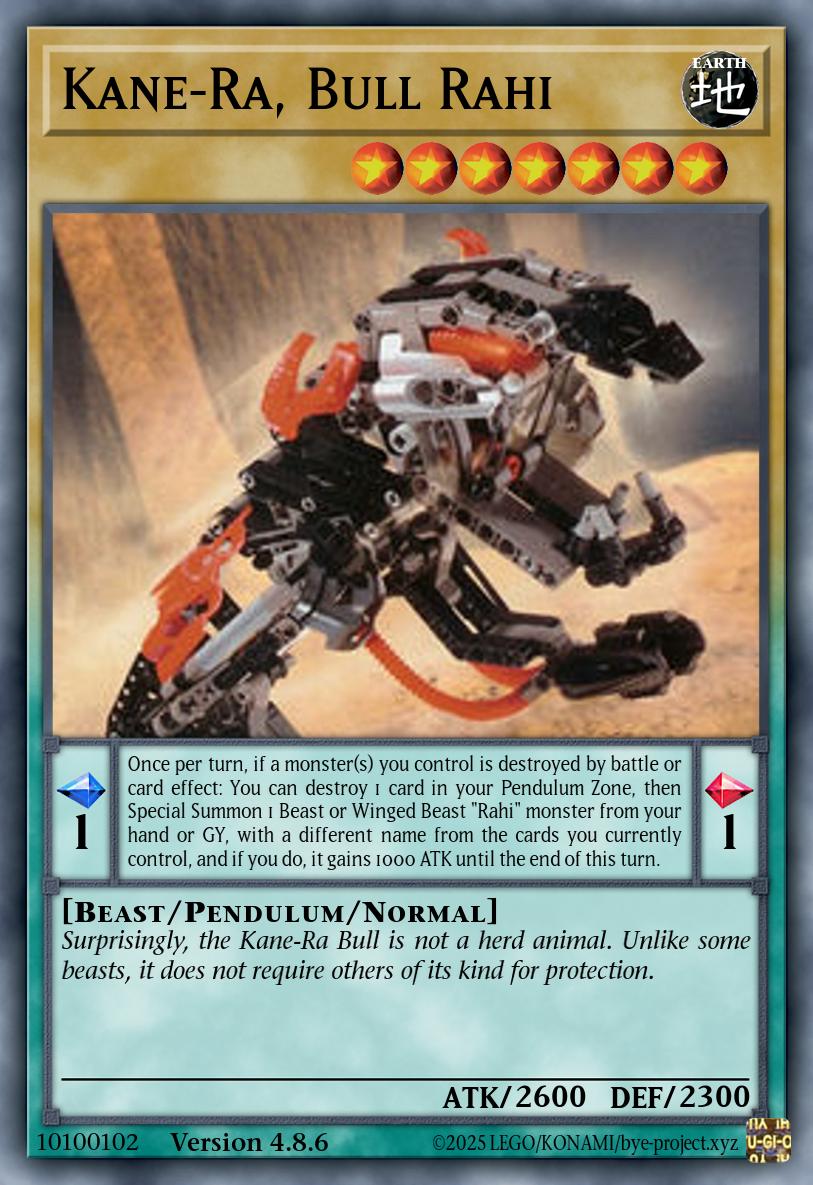
Kane-Ra, Bull Rahi
Normal Pendulum MonsterLevel 7 | Scale 1/1 | EARTH Beast | ATK 2600 / DEF 2300[ Pendulum Effect ]
Once per turn, if a monster(s) you control is destroyed by battle or card effect: You can destroy 1 card in your Pendulum Zone, then Special Summon 1 Beast or Winged Beast “Rahi” monster from your hand or GY, with a different name from the cards you currently control, and if you do, it gains 1000 ATK until the end of this turn.
—————————————-
[ Flavor Text ]
Surprisingly, the Kane-Ra Bull is not a herd animal. Unlike some beasts, it does not require others of its kind for protection.
One of those Normal Pendulums, the Kane-Ra, got the trigger condition of its Pendulum Effect downgraded so it only reacts if a monster on your field is destroyed. This change specifically targets the main intended combo between Kane-Ra and Muaka , where you pop a Rahi to search another one and then Special Summon that right away. Getting to do such a strong play without even needing to invest some kind of Summon just felt like one step too far.

Nui-Rama, Fly Rahi
Normal Pendulum MonsterLevel 5 | Scale 1/1 | WIND Insect | ATK 1800 / DEF 1700[ Pendulum Effect ]
You can target 1 face-up monster you control; Special Summon 1 Insect “Rahi” monster with a lower or equal Level from your Deck in Defense Position, also you cannot Special Summon monsters for the rest of this turn, except Insect monsters. You can only use this effect of “Nui-Rama, Fly Rahi” once per turn.
—————————————-
[ Flavor Text ]
A harsh buzz fills the air…a rustle of wings…a dark shape flying out of the sun…the warning signs of a Nui-Rama attack.

Nui-Rama, Fly Rahi
Normal Pendulum MonsterLevel 5 | Scale 1/1 | WIND Insect | ATK 1800 / DEF 1700[ Pendulum Effect ]
You can target 1 “Rahi” monster you control; Special Summon 1 Insect “Rahi” monster with a lower or equal Level from your Deck in Defense Position, also you cannot Special Summon monsters for the rest of this turn, except Insect monsters. You can only use this effect of “Nui-Rama, Fly Rahi” once per turn.
—————————————-
[ Flavor Text ]
A harsh buzz fills the air…a rustle of wings…a dark shape flying out of the sun…the warning signs of a Nui-Rama attack.
For the Nui-Rama, I believe I already pointed out in the release post that it has no actual reason to let you target any monster for its Insect Summon, so now that’s limited to Rahi.

Kirikori-Nui, Locust Rahi
Synchro Effect MonsterLevel 3 | WIND Insect | ATK 1400 / DEF 10001 “Rahi” Tuner + 1+ non-Tuner monsters
If this card is Synchro Summoned: You can send 1 “Rahi” card from your Deck to the GY; this card gains 500 ATK. You can only use this effect of “Kirikori-Nui, Locust Rahi” once per turn. You can banish this card until the Standby Phase of your next turn; destroy 1 card on the field.

Kirikori-Nui, Locust Rahi
Synchro Effect MonsterLevel 3 | WIND Insect | ATK 1400 / DEF 10001 “Rahi” Tuner + 1+ non-Tuner monsters
If this card is Special Summoned, or when this card declares an attack: You can send the top 3 cards of your Deck to the GY; until the end of this turn, this card gains 500 ATK for each “Rahi” card sent to the GY this way. You can only use this effect of “Kirikori-Nui, Locust Rahi” once per turn. You can banish this card until the Standby Phase of your next turn; destroy 1 card on the field.
What I also previously mentioned is that the Kirikori-Nui sending a card of your choice as cost is a poor design and would be replaced once I think of a good alternative. Well, I thought of one: It sends random cards as cost, and by being able to repeat that when attacking each turn, it highlights the cyclic nature of the locust swarms vanishing, returning, and feeding again and again. Very neat flavor, and doesn’t even lose any of its previous utility if you simply hit the right cards. Get it twisted.

Electric Bug, Zapping Rahi
Tuner Effect MonsterLevel 1 | LIGHT Insect | ATK 600 / DEF 300If this card is in your hand (Quick Effect): You can banish 1 “Rahi” monster from your GY or face-up Extra Deck; Special Summon this card, and if you do, you can negate the effects of 1 face-up monster your opponent controls, until the end of this turn. You can only use this effect of “Electric Bug, Zapping Rahi” once per turn.
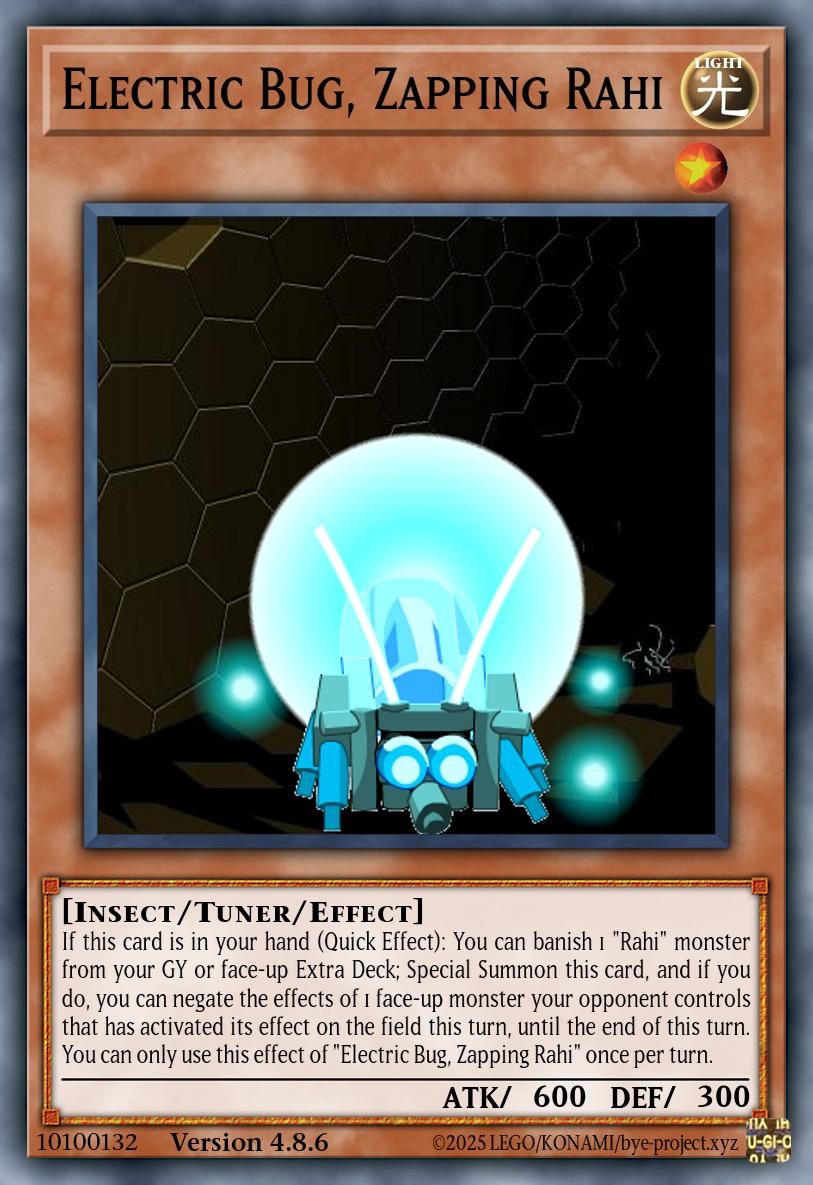
Electric Bug, Zapping Rahi
Tuner Effect MonsterLevel 1 | LIGHT Insect | ATK 600 / DEF 300If this card is in your hand (Quick Effect): You can banish 1 “Rahi” monster from your GY or face-up Extra Deck; Special Summon this card, and if you do, you can negate the effects of 1 face-up monster your opponent controls that has activated its effect on the field this turn, until the end of this turn. You can only use this effect of “Electric Bug, Zapping Rahi” once per turn.
The Electric Bug felt ever so slightly overtuned compared to the other handtrap-type Level 1 Insects, being able to just drop a non-targeting negate on your opponent to both disrupt plays and deal with established end board pieces. Now it has been restricted to pretty much only the former use case, through a fancy and unusual condition of only going after monsters that actually activated an effect this turn. You do still have a way to use this against a boss monster if you just bait its activation with something else and then chain the Electric Bug, but that is what I would consider a “banger play” and therefore 100% fine to allow.

Ranama, Lava Lurker Rahi
Synchro Effect MonsterLevel 4 | FIRE Reptile | ATK 2200 / DEF 6001 “Rahi” Tuner + 1+ non-Tuner monsters
When your opponent activates a card or effect (Quick Effect): You can target 2 face-up monsters on the field, including this card; place them face-up in their owners’ Spell & Trap Zones as Continuous Spells. You can only use this effect of “Ranama, Lava Lurker Rahi” once per turn. Once per turn, during the Standby Phase, if this card is a Continuous Spell: You can destroy 1 other Monster Card in a Spell & Trap Zone, and if you do, Special Summon this card.

Bog Snake, Venomous Rahi
Pendulum Effect MonsterLevel 4 | Scale 5/5 | WATER Reptile | ATK 1500 / DEF 1500[ Pendulum Effect ]
Once per turn: You can destroy up to 2 “Rahi” Monster Cards you control, and if you do, Special Summon 1 Reptile “Rahi” Synchro Monster from your Extra Deck whose Level is less than or equal to their total Levels (this is treated as a Synchro Summon), then place it face-up in your Spell & Trap Zone as a Continuous Spell.
—————————————-
[ Monster Effect ]
If this card declares an attack: You can inflict 300 damage to your opponent for each Monster Card in your Spell & Trap Zone. If this card is destroyed: You can place 1 Reptile “Rahi” monster from your GY or face-up Extra Deck face-up in your Spell & Trap Zone as a Continuous Spell. You can only use each effect of “Bog Snake, Venomous Rahi” once per turn.

Ranama, Lava Lurker Rahi
Synchro Effect MonsterLevel 4 | FIRE Reptile | ATK 2200 / DEF 6001 “Rahi” Tuner + 1+ non-Tuner monsters
When your opponent activates a card or effect (Quick Effect): You can target this card you control and 1 other face-up monster on the field or in your GY; place them face-up in their owners’ Spell & Trap Zones as Continuous Spells. You can only use this effect of “Ranama, Lava Lurker Rahi” once per turn. Once per turn, during the Standby Phase, if this card is a Continuous Spell: You can destroy 1 other Monster Card in a Spell & Trap Zone, and if you do, Special Summon this card.

Bog Snake, Venomous Rahi
Pendulum Effect MonsterLevel 4 | Scale 5/5 | WATER Reptile | ATK 1500 / DEF 1500[ Pendulum Effect ]
Once per turn: You can destroy up to 2 “Rahi” Monster Cards you control, and if you do, Special Summon 1 Reptile “Rahi” Synchro Monster from your Extra Deck whose Level is less than or equal to their total Levels (this is treated as a Synchro Summon), then place it face-up in your Spell & Trap Zone as a Continuous Spell.
—————————————-
[ Monster Effect ]
If this card declares an attack: You can inflict 300 damage to your opponent for each Monster Card in your Spell & Trap Zone. If this card is destroyed: You can place 1 face-up Reptile “Rahi” Pendulum Monster from your Extra Deck in your Pendulum Zone, also you cannot activate the effects of “Bog Snake, Venomous Rahi” for the rest of this turn.
Finally, a paired update on the Reptiles: The Ranama got subtly enhanced with the ability to pull monsters from your own GY into the backrow, which provided room to narrow the focus of the Bog Snake’s destruction effect down to placing only Pendulums into the proper Pendulum Zones – something the deck struggled to do before. Of course, when the Snake can destroy itself with its own Pendulum Effect (soft once per turn due to space limitations) and then re-scale itself, that opens up some unfortunate looping potential (well, looping twice), so to address that, I finagled a fresh type of quasi-HOPT that extends from the monster effect to the Pendulum Effect. Notably doesn’t cover the other monster effect that does burn damage, but since it only triggers when attacking, there’s no reasonable fear of FTKs here.
And now we’re actually done.
In Hindsight …
With another milestone cleared, this is a good moment to reflect on my design, testing, and documentation approaches of the past few years. For the most part, things have worked decently well, but there are a few key points where I see room for improvement in future development:
- Design-wise, I’d like to move away from archetypes that just repeat the same pattern for the six elements. Having a shared structure and maybe some basic common effects is fine, but looking at the trends of modern card design, I feel like I really should be giving each monster more of an individual role in gameplay. This is just a bit tricky from an adaptation standpoint since we’re still in the era of clone sets that didn’t really get much individual story focus, but I’ll be doing my best to figure something out.
- For testing and documentation, I revised my approach once more while working on the final BPEV showcase video, so next time I really should be at the point where I can just filter each card and pull out the footage I need to put that thing together. But that’s a behind-the-scenes matter anyway.
- Not being able to make a Best of Test for Toa Nuva and Bohrok-Kal until the very tail end of development (because I spread their cards out all the way) was kind of annoying, so I’ll try to take that into account when planning the order of releases for the next set.
Coming Soon to Theaters
Except not really, Mask of Light is direct-to-DVD. But still, look forward to the first release from the BMOL (three guesses what that stands for) expansion this summer! I’ve also started working on a Toa vs Bohrok campaign for Dungeon Duel Monsters that I’ll try to get up on their Discord later this month, so come check it out there if that sounds interesting.
Otherwise, see you again with the next release, sometime before the end of human history.


